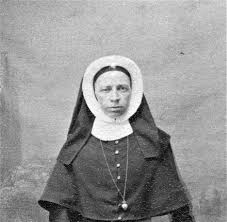
Early Life
Mother Augusta Volk was born in Bombach in the region of Baden, Germany in 1828, six years after the birth of Mother Theresa Weber, foundress of the German community that later would become the Sisters of the Most Precious Blood of O’Fallon, Missouri. Both were destined to lead the community during particularly trying times.
Mother Augusta entered at Gurtweil in October 1858 at the age of 30. She worked in the vestment department and was quite proficient. Her skills in other areas earned her an appointment by Roman authorities five years later as Superior of the Gurtweil Community. Sister Clementine Zerr was appointed president. Their roles, as delineated by Rome, overlapped.
In 1867, the Reverend Blaise Winterhalter, pastor in the American state of Illinois, invited the two women and their community to come to America. In 1870, forced by anti-Catholic fervor in Germany, the community needed to make the painful decision to disband or pull up stakes and migrate. They decided to leave, and in 1870, nine Sisters fled to America. Three more groups would follow, and by 1873, most of the community had gone to America. Mother Augusta Volk was strong and decisive, but she did allow Sisters to remain if they did not wish to leave Germany.
A Community Divided
Upon the community’s arrival, Bishop Baltes of Alton, Illinois, imposed conditions that Sisters had to meet in order to stay in Illinois. She felt the community could not accept his conditions and contacted the Diocese of St. Louis and was accepted. Guided by Vicar General Henry Muehlsiepen, the community temporarily settled at St. Agatha parish in St. Louis and then made its final home in O’Fallon, Missouri.
A new difficulty, a devastating one, soon confronted Mother Augusta Volk. She and Mother Clementine had different ideas about the dual governmental structure imposed by Roman authorities. A group of Sisters, led by Mother Clementine, felt that Mother Augusta was charting a course that was meant to achieve independence from Roman authorities. A move of this kind, they thought, belonged within the jurisdiction of Mother Clementine. Independence of action had not been Mother Augusta’s intention, but the difficulties of communicating with Rome had forced her to make decisions not approved in Rome. She had repeatedly written to Rome but had received no answers. Neither do these letters exist in the Roman Archives. Augusta wrote to a friend, Sister Wilhelmine, formerly from the Gurtweil Community, now in the Roman community:
“We then had to hear that we are separated from Rome. They wished to know nothing further from me or from the Sisters with me. We gave this gossip little faith. I thought it impossible. I knew that as far as I was concerned there was no offense, no disobedience against Superiors, at any rate, we would not be shut out without further questioning. I thought I would receive an answer after my third letter …
(Letter, 1876)
With a grieving heart but convinced of her position, she moved forward with the Sisters of the O’Fallon Community and forged them into a thriving Community which claims her as their Foundress in America. Mother Augusta led the Community until 1883. In that year, she returned to Europe to dispose of the Gurtweil property. This required an extended stay since the sale could not be negotiated immediately. Her stay was prolonged beyond the eventual sale of the property by the German chaplain, Rev. Anton Fraessle, who persuaded her to remain in Germany although she Written by Mary Joan Dyer, C.PP.S longed to return to O’Fallon.
Moving Forward
Deeply pained by her exile, she wrote to Sr. Wilhelmine in the Roman Community: “When I review all the happenings in Gurtweil and in America, I come more and more to the conviction that the dear Lord has made use of me, a poor unworthy being, as an instrument to extend his honor there and here, and in such a way, that I often, after the thing was accomplished, first begin to realize that it was best that way.” She died in 1893 and was buried in the Gurtweil parish cemetery. Years later, her remains were placed in a small chapel on our former Gurtweil property.
Mother Augusta was strong, aggressive, intelligent, insightful, capable, fearless, deeply grateful and often deeply pained. No doubt, she could also be difficult. She was the Superior called by God for a particular period in our history and to her we owe a great debt of gratitude for seeing us through it.
I hope it is OK to ask a question. I am he Archivist for the Diocese of Belleville, and am trying to help a family find some of their history. This person was the daughter of George Brendel and Catherine Brandl.
Did the ASCs have different letters behind their names in times past? I am trying to find out what congregation to which a certain sister belonged. Her name was Sister Cunegunda Brendel, Born April 24, 1872; Died January 13, 1935. The initials behind her name at the time of death: A.PP.S. She was buried from St. John the Baptist, Piopolis, IL.
Yes. When I was at a CppS orphanage (St. Louis, MO), one of the CppS sisters told me about the other Precious Blood community that had separated from O’Fallon/Ruma under Augusta Volk/Clementine Zerr. Their abbreviated initials in in 1959 were Ad.PPS or Ad.pps (Adorers of the Most Precious Blood.) Sister Barbara Payne at O’Fallon would know that both communities changed their initials over time. Once the Ruma sisters were ABC, then ASC after using AdPPS for a long time. – Joe Genna, Portland, Oregon